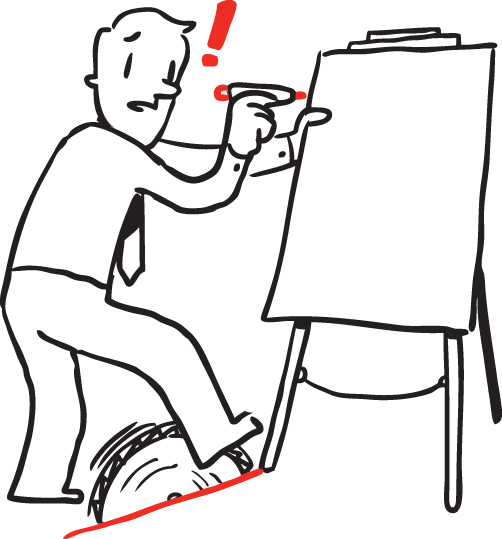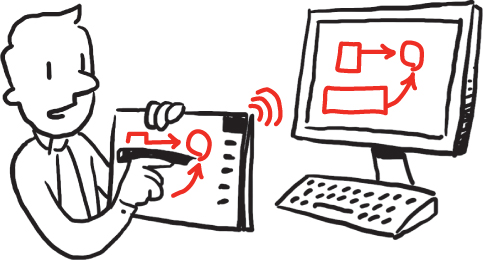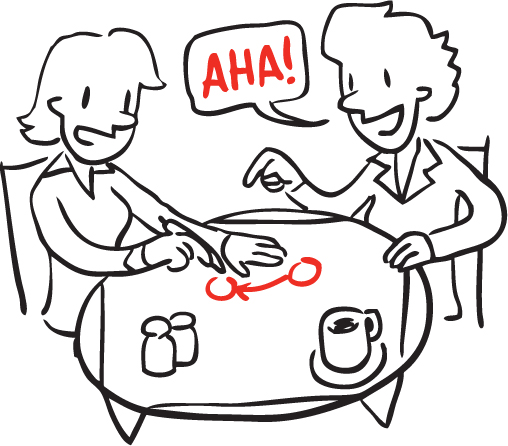
Regardless of whether you are an individual seller, a trainer, a marketer, or a sales executive, if you've made the investment to design and/or learn whiteboards for selling, a time will soon come when you will need to present it in a professional and competent fashion in a “live-fire” situation.
Even if you've been through a whiteboard symposium with the ability to present a whiteboard (or parts of it) to a customer or prospect the next day, you will still need ongoing practice to master all of the salient points and ensure you are 100 percent comfortable with the content and flow of the story. Here are seven steps that will enable you to master the visual content and story flow of any whiteboard in this book in two hours or less.
Once you have mastered the whiteboard on pen and paper, you can get together with some peers or, better yet, with a trusted customer, and present the whiteboard in role on an actual whiteboard, or over desktop sharing software using digital paper. It really doesn't matter to whom you present; it could be siblings, parents, friends, or even pets—one trainee actually presented to his dog because he was snowed in and couldn't get into the office to practice with co-workers!
Make sure you have these three necessary tools at your disposal before you start whiteboarding.

A very minor adjustment in stance can make a big difference when delivering a whiteboard presentation. Position yourself so your feet are perpendicular to the whiteboard surface, and be conscious to never alter this position except to turn and face your audience completely. It's a small detail, but it will prevent you from ever having your back to your audience. This rule doesn't apply very well to left-handed whiteboarders, but the principle still applies.

A good way to remember that you must maintain a good stance is to imagine a laser beam or other limb-threatening device extends from the ceiling down along the x-axis of your drawing surface. If you ever move your right foot across this invisible line, then you'll lose a shoe size or two.
Because you are now using the open stance, you can truly engage your prospect in an interactive dialogue. Smile. Make eye contact. Use hand gestures. When whiteboarding in front of larger groups, remember to project and speak up a bit. This will help keep your audience focused on you instead of on their smartphones and tablets.
One of the most common missteps is to write on the whiteboard in silence, and then turn to your audience and regurgitate what you have just drawn, word-for-word. This creates an awkward pause that interrupts the flow of your presentation, giving your audience an opening to tune out and check e-mail. With just a little bit of practice—and by using the open stance—you can easily overcome this. Be sure to talk as you draw, then turn and face your audience to expand on the topic.
If you are one of those sales professionals who wouldn't dare approach the whiteboard because you think you have poor penmanship, be prepared to surprise yourself. Bad penmanship is primarily a result of going too fast and not knowing your story. A good story is not a rushed story, so pace yourself, have fun, take time to engage your audience, and don't feel the need to scribble furiously on the whiteboard. The best outcome is when your prospect or customer writes “save” on the whiteboard, at which point it becomes an internal sales tool that lives on long after you have departed.
A frequent question is, “How long should my whiteboard presentation be?” Naturally, this depends on the situation, the type of whiteboard, your audience, and their level in the organization. A general rule of thumb is that your basic solution whiteboard story should be 7 to 15 minutes long, if you were to present it without interruption. Once you add interaction, you could easily fill an hour-long time slot. In fact, because the whiteboarding approach is so engaging, you will frequently find that meetings start to run over, without objection from your prospects.
Based on how much time you have and to whom you are presenting, you can put in or pull out content as appropriate, and customize the basic whiteboard story flow. What is important is that you use the same basic content, visual structure, and flow, regardless of your audience. It would be impractical to have a different story line for each title in your target organization.
Using simple web conferencing software, and a revolutionary digital paper solution called Papershow, you can easily simulate a fully virtual whiteboarding experience at an extremely affordable price (about $175). This can make a big difference to your return-on-sales; you won't need to travel but you can still conduct a fully interactive sales call remotely through any standard web conferencing system. This approach does more than just save travel costs; you'll command greater attention from your prospects. We have found that while 50 percent of web conferencing viewers intermittently leave a remotely shared PowerPoint presentation to access e-mail and other applications, the attrition rate is less than 10 percent using the visual storytelling approach with digital paper.

Another benefit of digital paper over remote slide sharing is you can annotate the whiteboard with the feedback and input of your prospect (using a different color, perhaps), and then automatically create a PDF file of the whiteboard that you can e-mail directly to your prospect from within the Papershow application.
Whereas field personnel have the luxury of face-to-face interactions with prospects (either in a conference room or at lunch on butcher paper), inside salespeople should also have access to these techniques and a mechanism to engage and nurture leads early in the sales process, thus increasing conversion rates and shortening the sales cycle. If you are part of an inside sales team, just because you are not face-to-face with your prospect, it doesn't mean you cannot benefit from visual storytelling techniques. The virtual whiteboarding scenario described above allows you to have interactive dialogues and qualification discussions using remote whiteboarding. Imagine the difference between saying “I will send you an e-mail with more information” and “Do you have access to a web browser right now? Why don't we jump on a quick web conference so I can spend 10 minutes to show you what I'm talking about with a virtual whiteboard?” In this case you would use the Papershow digital paper discussed earlier, or another tablet-based drawing technology.
One of the most effective ways to use your whiteboard is at lunch with a customer on butcher paper at your favorite steakhouse, seafood joint, or pasta place, or after work for drinks at the bar on a paper placemat. Lunch at a restaurant is a neutral setting for an engaging interaction that is less formal than an office during business hours. The obvious time to pull out the pen is after you've ordered and before the food arrives. The conversation can continue over lunch and then wrap up over coffee, with documentation of concrete next steps. At the conclusion of your meeting, rip off the square of paper containing your visual discussion, fold it up, and hand it to your prospect or customer.

What kind of pen should you use? Pulling out a bunch of multicolored markers or crayons won't make a very good impression. Just bring along your handy Bic 4-color ballpoint. And one for your customer, of course!